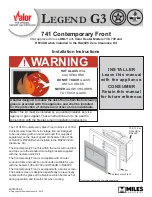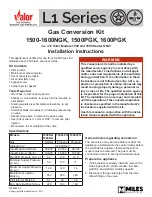
Grand Bay 40 Direct Vent Freestanding
Page 30
January 2000
VERTICAL TERMINATIONS (cont.)
INSTALLATION INTO AN EXISTING MASONRY CHIMNEY
Step 1.
Before cutting any holes, assemble the desired sections of direct vent pipe to determine
the center of the masonry penetration.
Step 3.
Secure the flashing (SDV #705C) to the
top of the masonry chimney using a bead
of non-hardening sealant-adhesive. If the
flashing is larger than the top of the
chimney, cut and fold flashing as needed
to fit chimney (Figure 24).
Step 4.
To determine the length of flex needed,
measure from 3 (76mm) above the top
of the flashing down to the level of the
opening. Add the distance from the
center of the chimney out through the
wall. Cut a piece of 4 (102mm) flex to
this length (extended to its nominal
length). Be sure to leave 2-3 (51mm-
76mm) of flex above the existing
chimney to allow for connection to the
termination kit.
FIG. 23
Step 2.
Once the center point of the penetration
has been determined, cut a 6 (152mm)
diameter hole in the masonry. If the hole
is too large, the retro connector might
not mount properly; if the hole is too
small, the appliance might starve for
intake air. If there is a frame wall in front
of the masonry wall, cut and frame a 10
(254mm) square opening in the wall
(centered around the 6 [152mm]
masonry opening). If there is sheet rock
only (no studs) in front of the masonry
the 10 (254mm) opening is still needed,
but does not need to be framed. This
allows the retro connector to mount
directly on the masonry and provide the
correct clearances to combustibles (see
Figure 23).
FIG. 24
VENTING:
EXISTING
MASONR
Y CHIMNEY











































